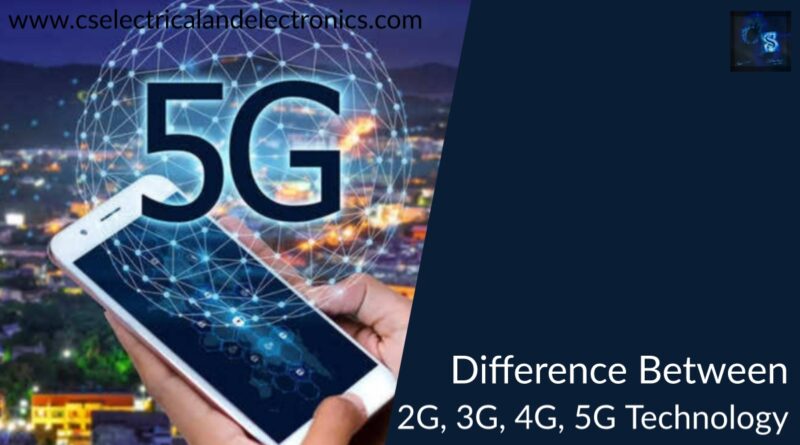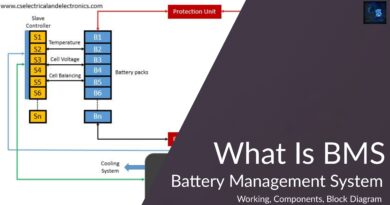Difference Between 2G, 3G, 4G, 5G Technology, Benefits, Drawbacks
Hello guys, welcome back to our blog. In this article, we will discuss the difference between 2G, 3G, 4G, 5G technology, the benefits of 2G, 3G, 4G, 5G technology, and their drawbacks.
If you have any electrical, electronics, and computer science doubts, then ask questions. You can also catch me on Instagram – CS Electrical & Electronics.
Also, read:
- Difference Between PI, PID, Fuzzy Logic Controller, Disadvantages.
- Difference Between BLDC And PMSM Motor, Brushless DC Motor.
- Difference Between Renewable And Non-Renewable Energy Sources.
Difference Between 2G, 3G, 4G, 5G Technology
G stands for Generation. The speed of the connection depends upon the signal strength which is shown as 2G, 3G, 4G, 5G, etc. The only aim of wireless communication is to provide high-quality and reliable communication.
2G Technology
2G network refers to the second generation of mobile networks. The radio signals used by the 2G network were digital. As the digital signals are able to cover a long distance these signals are introduced in second-generation networks.
GSM technology is used. Initially, it was named Groupe special module and after that when it was globally accepted with the name Global system for mobile communication. It is the technology in the second generation for voice communication. Communication over long distances is only possible because of GSM technology.
After voice communication, our main aim is data which means we required from a server end. Another technology 2.5G the technology is named GPRS which stands for General packet radio service which means packet transmission through an air interface. No use of land wire to the computer and accessing internet connection.
The data rate in the GPRS is very less so we are required to have more data rates. So, we have 2.75G with the name EDGE (Enhanced data rates for GSM Evolution).
- 2G network offers enabled services such as Multimedia messages.
- The bandwidth used by the 2G network is 30 to 200kHz.
- Data speed is up to 64 kbps.
Advantages of 2G technology
- As the signals are digital they consume less battery power.
- 2G network offers privacy which can be manageable with earlier technologies.
Disadvantages of 2G technology
- The weaker signal cannot be reached by cell towers in less populous areas.
3G Technology
The 3G network is named UMTS – Universal Mobile Terrestrial or Telecommunication system. 3G has a data rate of 384 kbps whereas for EDGE the data rate is about 170 kbps and for GPRS the data rate is 56 to 64 kbps. This network is also having a feature of video calling.
Advantages of 3G technology
- 3G technology has more bandwidth and high security.
- The data rates in 3G networks are fixed and variable.
Disadvantages of 3G technology
- Base stations for connectivity should be closer to each other.
4G Technology
4G is the fourth most generation network of mobile phone communication technology. It is next-generation to the third-generation standards. 4G system provides mobile ultra-broadband internet access. 4G has high data rates as the boost to a more 4G network is 1Gbps (Gigabit per second) for stationary uses and 100 Mbps (Mega bit per second) for high mobility uses.
So, the fourth generation is evolved because of the requirement for high data rates. 4G network is a board with a concept of fully packet-switched which means that there is no concept of circuit switching as we have in 3G and 2G cellular systems. So, packets that fully IP and packet switch network.
So, add basic architecture which is divided into two bars one is the radio network and the other is the correct network. The evolution of a new architecture is learning our 4G networks. So, that evolution of new architecture is SAE (System Architecture Evolution). It is an evolution of the architecture of the 4G network.
Advantages of 4G technology
- 4G network has uninterrupted connectivity.
- 4G network has amazing speed.
- An increase in bandwidth leads to a much faster data transfer speed.
Disadvantages of 4G technology
- 4G network will most likely have its initial bugs and glitches which will annoy the user.
- 4G networks use antennas and transmitters so users would experience much poorer battery life.
- The cost of the network is high.
5G Technology
5G is a fifth-generation Technology that offers more power and features than a handheld phone. It is powerful and in huge demand in the future. It offers worldwide cellular phones, high connectivity, bright future. 5G is the biggest area in research and development.
There will be a significant increase in data rate, but there is a drastic increase in energy efficiency, frequency efficiency, spectrum efficiency, and efficiency of other devices. We require to increase the efficiency of all the devices and we want to reduce energy usage.5G is introduced to meet the data rate to meet the current demands.
By using additional higher frequency radio waves we can increase the speed partly. 5G network is composed of three types of cells in which each cell requires specific antenna designs. The speed of 5G ranges from 50 Mbps to over a Gbps. Low band spectrum efficiency offers the greatest range. To keep the bit error low 5G uses an adaptive signal coding system.
Advantages of 5G technology
- 5G is more efficient and effective.
- 5G network can be easily manageable with previous generation networks.
- 5G network has the possibility to provide uninterrupted connectivity across the world.
Disadvantages of 5G technology
- 5G Technology is still under process and research is going on.
- 5G Technology needs high cost due to developing infrastructure.
- Most of the old devices may not support 5G and they can be replaced.
Difference Between 2G, 3G, 4G, 5G Technology
| Technologies / Features | 2G/2.5G | 3G | 4G | 5G |
| Evolution | 1980 | 1990 | 2000 | 2010 |
| Deployment | 1999 | 2002 | 2010 | 2015 |
| Data Rate | 14.4-64 kbps | 2 Mbps | 200 Mbps to 1 Gbps for low mobility | 10 Gbps to 100 Gbps |
| Famous Standards | 2G: GSM, CDMA 2.5G: GPRS, EDGE, 1xRTT | WCDMA, CDMA-2000 | LTA, WiMAX | Not yet defined |
| Technology Behind | Digital cellular technology | Broad bandwidth CDMA, IP technology | Undefined IP and seamless combination of broadband. LAN/WAN/PAN/WLAN | Undefined IP and seamless combination of broadband. LAN/WAN/PAN/WLAN |
| Service | 2G: Digital Voice, SMS 2.5G: Voice+Data | Integrated high-quality audio, video, and data | Dynamic information access, wearable devices | Dynamic information access, wearable devices with AI capabilities |
| Multiplexing | TDMA, CDMA | CDMA | CDMA | CDMA |
| Type Of Switching | 2G: Circuit 2.5G: Circuit and packet | Packet | Packet | Packet |
| Handoff | Horizontal | Horizontal | Horizontal and Vertical | Horizontal and Vertical |
| Core Network | PSTN | Packet network | Internet | Internet |
This was about the difference between 2G, 3G, 4G, 5G technology. I hope this article may help you all a lot. Thank you for reading.
Also, read:
- 100 + Electrical Engineering Projects For Students, Engineers
- 1000+ Electronics Projects For Engineers, Diploma, MTech Students
- 1000+ MATLAB Simulink Projects For MTech, Engineering Students
- 500+ Embedded System Projects For Engineer, Diploma, MTech, PhD
- 500+ Projects For Diploma Electrical, Electronics Student, Diploma Project
- 8051 Microcontroller Timers, TCON Register, TMOD Register
- Advancements In 3D Printing Technology And It’s Future
- Advancements In Power Electronics For Energy Efficiency
Author Profile
- Content Writer








